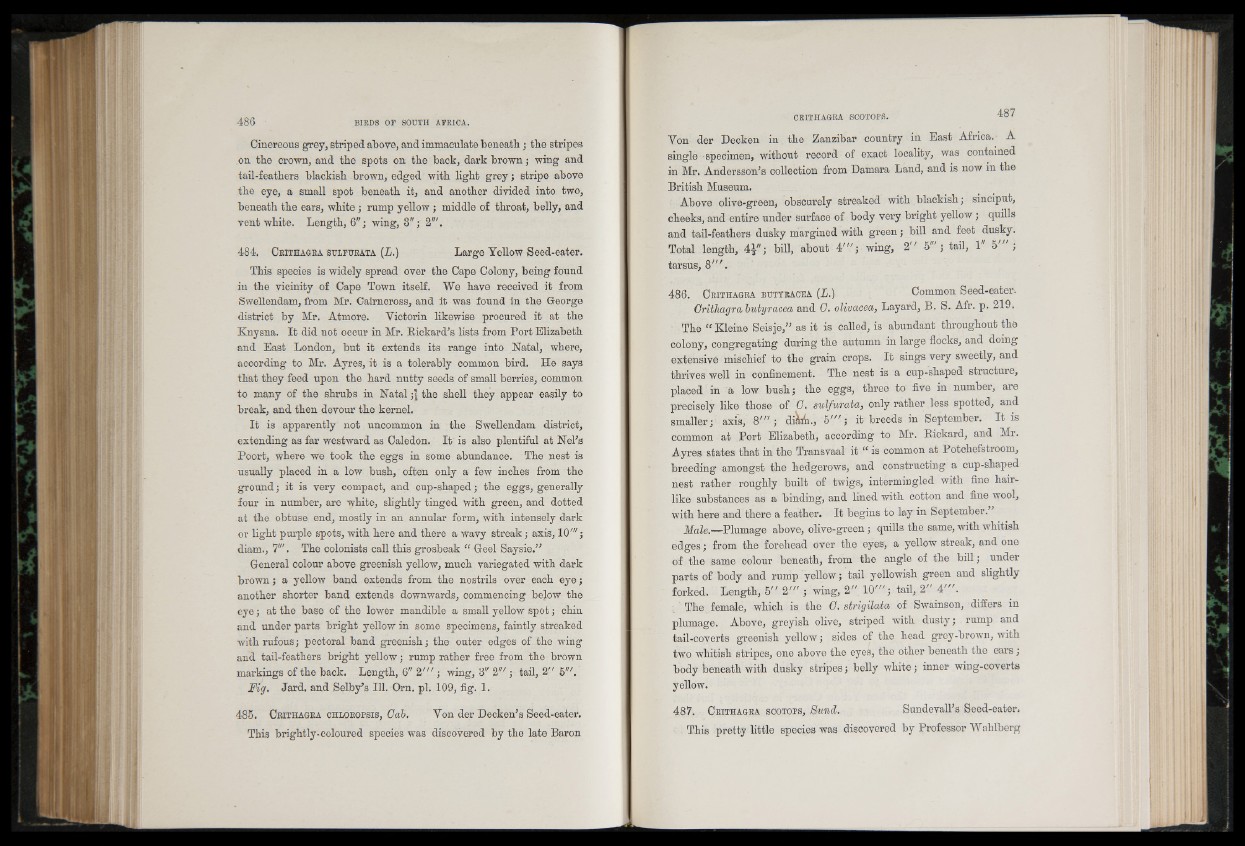
Cinereous grey, Btriped above, and immaculate beneatb ; tbe stripes
on the crown, and the spots on the back, dark brown; wing and
tail-feathers blackish brown, edged with light grey; stripe above
the eye, a small spot beneath it, and another divided into two,
beneath the ears, white; rump yellow; middle of throat, belly, and
vent white. Length, 6"; wing, 3"; 2"'.
484. C rithagra sulfurata (L.) Large Yellow Seed-eater.
This species is widely spread over the Cape Colony, being found
in the vicinity of Cape Town itself. We have received it from
Swellendam, from Mr. Cairncross, and it was found in the George
district by Mr. Atm ore. Yictorin likewise procured it at the
Knysna. I t did not occur in Mr. Rickard's lists from Port Elizabeth
and East London, but it extends its range into Natal, where,
according to Mr. Ayres, it is a tolerably common bird. He says
that they feed upon the hard nutty seeds of small berries, common
to many of the shrubs in Natal the shell they appear easily to
break, and then devour the kernel.
It is apparently not uncommon in the Swellendam district,
extending as far westward as Caledon. I t is also plentiful at Nel’s
Poort, where we took the eggs in some abundance. The nest is
usually placed in a low bush, often only a few inches from the
ground; it is very compact, and cup-shaped; the eggs, generally
four in number, are white, slightly tinged with green, and dotted
at the obtuse end, mostly in' an annular form, with intensely dark
or light purple spots, with here and there a wavy streak; axis, 10'";
diam., 7'". The colonists call this grosbeak “ Geel Saysie.”
General colour above greenish yellow, much variegated with dark
brown; a yellow band extends from the nostrils over each eye;
another shorter band extends downwards, commencing below the
eye; at the base of the lower mandible a small yellow spot; chin
and under parts bright yellow in some specimens, faintly streaked
with rufous; pectoral band greenish; the outer edges of the wing
and tail-feathers bright yellow; rump rather free from the brown
markings of the back. Length, 6" 2 " '; wing, 3" 2'"; tail, 2" 5'".
Fig. Jard. and Selby’s 111. Orn. pi. 109, fig. 1.
485. C rithagra ch lo rop s is , Cab. Von der Decken’s Seed-eater.
This brightly-coloured species was discovered by the late Baron
Von der Decken in the Zanzibar country in East Africa. A
single specimen, without record of exact locality, was contained
in Mr. Andersson’s collection from Damara Land, and is now in the
British Museum.
Above olive-green, obscurely streaked with blackish; sinciput,
cheeks, and entire under surface of body very bright yellow; quills
and tail-feathers dusky margined with green; bill and feet dusky.
Total length, 4-|"; bill, about 4 '" ; wing, 2 ' 5' ; tail, 1 5 ;
tarsus, 8 '" .
486. C rith a gra buttracea (L.) ( Common Seed-eater.
Crithagra butyracea and 0. ol/ivacea, Layard, B. S. Afr. p. 219.
The “ Kleine Seisje,” as it is called, is abundant throughout the
colony, congregating during the autumn in large flocks, and doing
extensive mischief to the grain crops. It sings very sweetly, and
thrives well in confinement. The nest is a cup-shaped structure,
placed in a low bush; the eggs, three to five in number, are
precisely like those of C. sulfurata, only rather less spotted, and
smaller; axis, 8'" ; d iW , 5 '" ; it breeds in September. It is
Common at Port Elizabeth, according to Mr. Rickard, and Mr.
Ayres states that in the Transvaal it “ is common at Potchefstroom,
breeding amongst the hedgerows, and constructing a cup-shaped
nest rather roughly built of twigs, intermingled with fine hair-
like substances as a binding, and lined with cotton and fine wool,
with here and there a feather. It begins to lay in September.
Male.—Plumage above, olive-green; quills the same, with whitish
edges; from the forehead over the eyes, a yellow streakj and one
of the same colour beneath, from the angle of the bill; under
parts of body and rump yellow; tail yellowish green and slightly
forked. Length, 5" 2"' ; wing, 2" 10'"; tail, 2" 4 '" .
i The female, which is the C. strigilata of Swainson, differs in
plumage. Above, greyish olive, striped with dusty; rump and
tail-coverts greenish yellow; sides of the head grey-brown, with
two whitish stripes, one above the eyes, the other beneath the ears;
body beneath with dusky stripes; belly white; inner wing-coverts
yellow.
487. C r ith a gra scotops, Sund. Sundevall’s Seed-eater.
This pretty little species was discovered by Professor Wahlberg